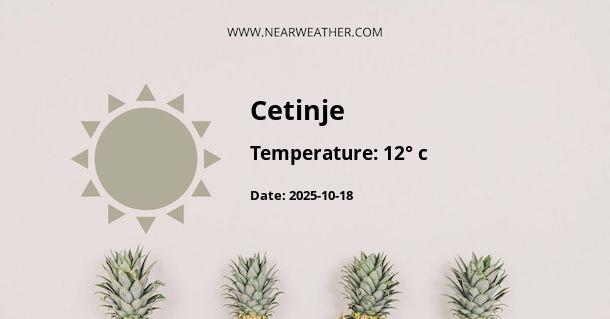Understanding Cetinje's Distinct Climate and Year-Round Weather Patterns
Cetinje, nestled among the rugged terrain of Montenegro, offers a unique climatic experience shaped by its geographic location and elevation. This historic city, lying in a valley at the foot of Mount Lovćen, experiences a modified continental climate, with particular weather characteristics that differentiate it from other Montenegrin localities. Below, we delve into the details of Cetinje's climate, its seasonal weather patterns, and the meteorological factors influencing its year-round weather.
Geographic and Climatic Overview of Cetinje
Geographically positioned at an altitude of approximately 670 meters above sea level, Cetinje's climate is significantly influenced by the surrounding topography and its inland location. This altitude bestows upon the city cooler temperatures compared to the Adriatic coast, particularly during the winter months.
Seasonal Weather in Cetinje
Spring
Spring in Cetinje ushers in a gradual warming trend with temperatures commonly ranging from a low of 5°C (41°F) to a high around 15°C (59°F). Precipitation is frequent during these months, often in the form of rain but with occasional late snowfalls, particularly in March and early April.
Summer
The summer climate is generally comfortable, with July being the warmest month. Temperature averages for this season usually sit between 14°C (57°F) and 28°C (82°F). While experiencing lower humidity than coastal regions, Cetinje can still receive occasional heavy downpours which influence the overall climate pattern.
Autumn
Autumn sees a return of cooler weather, initiating in September with temperatures ranging from 10°C (50°F) to 22°C (71°F). This period is marked by increased rainfall, which accumulates significantly towards the late autumn months.
Winter
Winter in Cetinje is characterized by its relatively cold and snowy conditions, with temperatures often hovering around freezing. From December through February, average temperatures span from -3°C (27°F) to 7°C (45°F). Snowfall is common, and the surrounding mountains can retain their white caps well into spring.
Detailed Climatic Data for Cetinje
- Temperature: Average annual temperature sits at approximately 11°C (51.8°F).
- Precipitation: Cetinje receives abundant precipitation, with annual averages exceeding 2000 mm. The wettest months typically span from October to December.
- Snow: Snowfall is customary in the winter months, contributing to a median of several weeks of snow cover throughout the year.
- Wind: The city can encounter winds varying in intensity, influenced by the mountainous terrain, often intensifying during the winter season.
Monthly Climate Averages Chart
| Month | Average High (°C) | Average Low (°C) | Precipitation (mm) |
|---|---|---|---|
| January | 5 | -1 | 192 |
| February | 6 | -1 | 175 |
| December | 7 | 0 | 209 |
Climate Influences and Extremes
The climate of Cetinje is frequently defined by its extremes. Meteorological influences such as the altitude, nearby Adriatic Sea, and the orographic lift provided by Mount Lovćen contribute to these conditions:
"Orographic lift occurs when an air mass is forced from a low elevation to a higher elevation as it moves over rising terrain. This can lead to increased precipitation on the windward side and contribute to higher levels of precipitation in Cetinje compared to other regions at similar latitudes."
Extreme temperatures, both high and low, are infrequent but not unheard of. Winters can dip below -10°C (14°F) during cold snaps, while summer highs occasionally exceed 30°C (86°F).
Understanding Local Weather Phenomena
Cetinje is susceptible to local weather phenomena that can cause sudden changes in weather conditions. Bora winds, for instance, strong gusty winds descending from the mountains to the coast, can affect the temperature and make it feel significantly colder.
Another notable phenomenon is the occurrence of temperature inversions, particularly during the winter, where cold air becomes trapped in the valley beneath a layer of warm air, often leading to prolonged foggy conditions.
Implications of Cetinje's Weather on Travel and Activities
When visiting Cetinje, understanding its climate is essential. For those interested in exploring its historical streets and monasteries, the milder temperatures of late spring and early autumn may be ideal. Summer months, while attractive for their warmth, can still experience sudden rain showers. Hence, packing an umbrella is advisable.
Winter sports enthusiasts will find the snowy landscapes around Cetinje inviting, with nearby slopes offering opportunities for skiing and snowboarding. However, travel during the winter months may require caution due to snow-covered roads and the potential for icy conditions.
Adapting to Climate Change
As is the case worldwide, Cetinje is feeling the effects of climate change, with notable shifts in precipitation patterns and temperature extremes. This has implications for agriculture, water resources, and the preservation of its historical heritage. Local and national authorities are engaged in efforts focused on sustainability and resilience in response to these environmental challenges.
Final Thoughts on Cetinje's Climate
Cetinje's climate presents a collage of meteorological features, knitting together continental and Mediterranean influences. This city's weather is captivating not just for its variability but also for the ways in which it shapes the local culture, activities, and the very character of Cetinje itself. A comprehensive understanding of its climate is not only key for residents and policymakers in planning and adaptation efforts but also for visitors seeking to experience the grandeur of Montenegro's old royal capital in its full seasonal array.
A - Cetinje's Latitude is 42.390629 & Longitude is 18.914169.
A - Weather in Cetinje is 6° today.
A - Climate Conditions in Cetinje shows overcast clouds today.
A - Humidity in Cetinje is 82% today.
A - Wind speed in Cetinje is 14.8 km/h, flowing at 45° wind direction. today.
